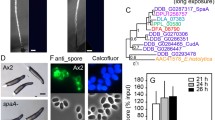Abstract
Lig1 was found in a differential-display screen for early genes expressed during phytochrome-controlled sporulation of Physarum polycephalum plasmodia. A stretch of 218 amino acids of the predicted sequence of Lig1 shares 32% sequence identity to that of the Schizosaccharomyces pombe cell-cycle and DNA-damage checkpoint gene hus1. In addition Lig1 is homologous to proteins of unknown function in Homo sapiens (35% identity) and Mus musculus (31% identity). Induction of lig1 expression was found to be controlled downstream from the point of integration of the phytochrome-activated pathway and the pathway sensing the metabolic state, but upstream of the developmental switch. The lig1 expression level in individual plasmodia correlated positively with the probability to sporulate. Sensory control of the lig1 expression level and its association with the developmental switch suggests a possible mechanism for the coordination of differentiation and the control of cell-cycle progression during the sporulation of P. polycephalum.
Similar content being viewed by others
Author information
Authors and Affiliations
Additional information
Received: 1 March / 26 March 1999
Rights and permissions
About this article
Cite this article
Kroneder, R., Cashmore, A. & Marwan, W. Phytochrome-induced expression of lig1, a homologue of the fission yeast cell-cycle checkpoint gene hus1, is associated with the developmental switch in Physarum polycephalum plasmodia. Curr Genet 36, 86–93 (1999). https://doi.org/10.1007/s002940050476
Issue Date:
DOI: https://doi.org/10.1007/s002940050476




